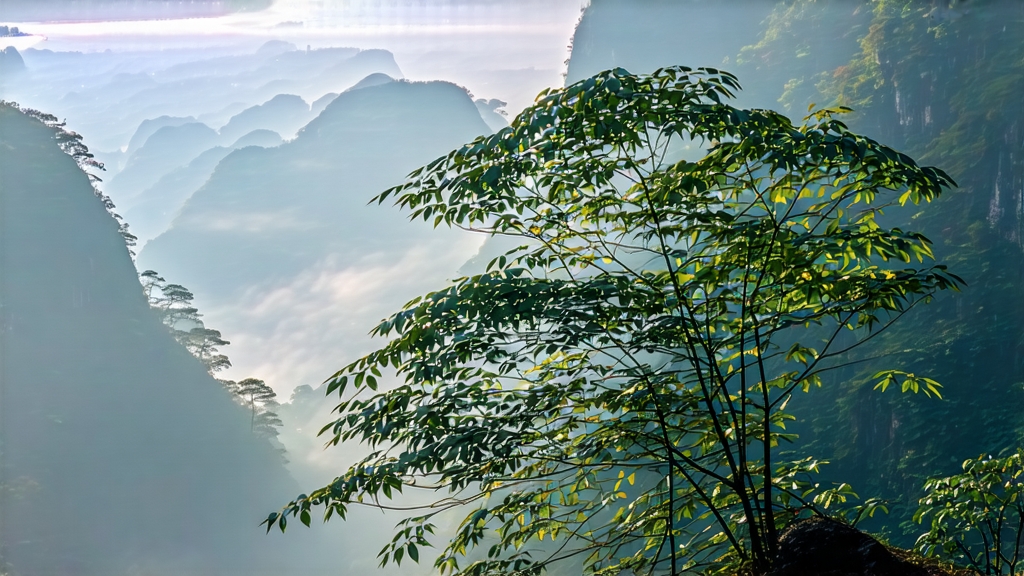
Tai Ping Hou Kui is not merely a green tea; it is a living scroll of Chinese landscape, history and craftsmanship. Grown only along the narrow, mist-locked banks of the Tai Ping Gorge in Huangshan’s northern foothills, this tea carries a name that translates literally as “Peaceful Monkey Leader,” a title that still sparks curiosity in every language. According to local chronicles written during the late Qing dynasty, the original mother bushes clung to the inaccessible cliffs above the river. Villagers noticed that monkeys living in the crags would occasionally break tender shoots and drop them into passing boats. The fishermen brewed the stray leaves, found the liquor astonishingly fragrant, and thereafter tried to imitate the long, slender shape of the leaves when they began cultivating bushes on lower terraces. Whether myth or marketing, the story endures because it captures the tea’s wild origin and the reverence it commands.
Geography is the first secret. The gorge funnels humid air from the Yangtze River delta deep into Anhui province, creating a pocket where morning fog lingers until noon. Sunlight is diffused, ultraviolet levels are high, and the temperature fluctuates dramatically between day and night. These conditions slow photosynthesis, allowing amino acids—especially L-theanine—to accumulate while catechins remain moderate. The result is a tea that is both brothy-sweet and brisk without excessive astringency. The soil is a stony, slightly acidic granite derivative that drains instantly after the region’s frequent cloudbursts, forcing roots to dive deep for minerals. Locals insist that the faint “orchid” note for which Hou Kui is famous is impossible to replicate even in neighboring villages only ten kilometers away.
Unlike most green teas that reward early picking, Tai Ping Hou Kui is deliberately harvested when the leaf has reached an almost exaggerated maturity. Pluckers wait until the standard “one bud with two leaves” has lengthened to nearly eight centimeters, yet still remains tender enough to snap without fiber. Timing is critical: pick too early and the finished tea lacks the signature long, straight silhouette; pick too late and the veins lignify, refusing to bend during the crucial shaping step. Experienced pluckers work only between 7 a.m. and 10 a.m., while dew is still evaporating, ensuring that surface moisture does not complicate the kill-green stage.
The craft sequence that follows has remained virtually unchanged since 1900. First, the fresh leaves are spread in bamboo trays and “sun-wilted” for thirty minutes—an unusual step for green tea that gently reduces grassy notes. Next comes high-temperature pan firing, but instead of the vigorous tossing used for Longjing, Hou Kui leaves are pressed flat against the hot iron surface with a padded cotton mitt. The pressure drives out moisture while setting the cell walls in an extended posture. Immediately afterward, still-hot leaves are laid on a bamboo screen and five to six layers are sandwiched together. A master craftsman rolls a pin back and forth, further elongating the leaf to its final sword-like form. The pin must be moved with the rhythm of a calligrapher’s wrist: too slow and the leaf cracks; too fast and it curls. After shaping, the tea is baked three times over charcoal embers at descending temperatures—110 °C, 90 °C, 70 °C—each bake separated by an hour of resting so that residual moisture migrates outward. The entire process stretches across a full day and night, demanding an artisan’s stamina and an insomniac’s schedule.
Finished leaves are among the largest in the tea world: typically 6–8 cm long and 1 cm wide, flat as a blade of grass yet intact at the edges. The color is a mottled army green with a faint frost of silver down the midrib. When held to the light, tiny reticulated veins shimmer like fish bones, evidence that cell structure survived the brutal pressing intact. Ten grams—about fifteen leaves—can blanket the entire bottom of a tall glass.
Brewing Hou Kui is theater, and glassware is non-negotiable. A tall, cylindrical tumbler allows the leaves to stand on end, slowly pirouetting as they absorb water. Begin by warming the glass with 85 °C water, then pour 150 ml along the wall to avoid scorching. The first infusion should last no more than forty-five seconds; subsequent steeps can extend by fifteen-second increments. Watch the leaves unfurl like green banners, releasing a fragrance that moves from fresh fava bean to ripe loquat and finally to a haunting orchid note that seems to arrive after you exhale. The liquor is the